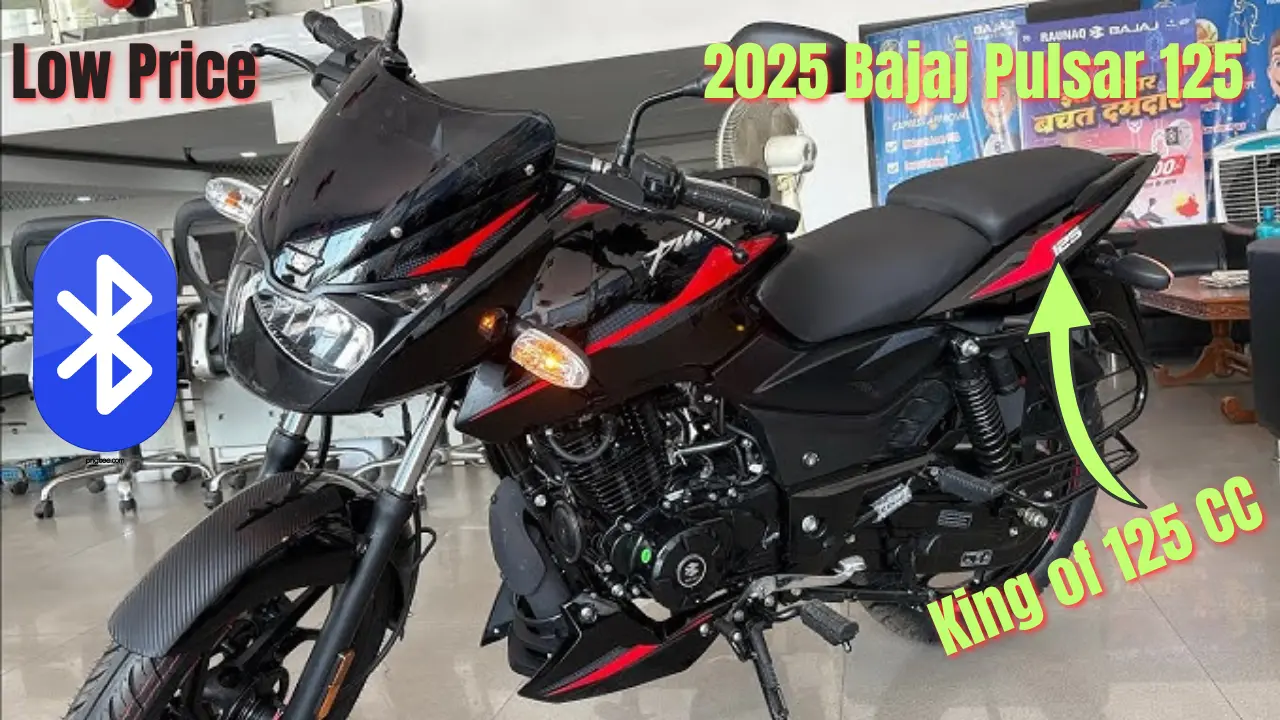2025 Bajaj Pulsar 125: The 2025 Bajaj Pulsar 125 continues being India’s most wallet-friendly ticket into the iconic Pulsar club, delivering genuine sportsbike vibes without making your bank account cry. Starting at ₹85,549, it’s basically saying “hey, you can have that Pulsar swagger without eating maggi for three months straight.”
What’s Actually New This Time Around
Look, Bajaj hasn’t reinvented the wheel here, but they’ve thrown in some updates that actually matter. The biggest deal? A proper digital console with Bluetooth—finally dragging the 125 kicking and screaming into 2025. Your phone can now talk to your bike, which means call alerts and SMS notifications right there on the dash. Navigation? Nah, not yet, but baby steps, right?
There’s also a USB port now (seriously, what took so long?), and LED tail lights that make the bike look less like it time-traveled from 2015. The headlight’s still halogen though—classic Bajaj cost-cutting that’s getting harder to defend when your neighbor’s Activa has LEDs.
The Heart of the Matter: Engine Talk
Same old 124.4cc single-cylinder motor that’s been chugging along reliably across Bajaj’s 125cc lineup. It makes 11.8 PS and 10.8 Nm of torque—numbers that sound pretty meh until you actually ride the thing.
Around town, this engine’s a gem. Enough punch off the line to keep you ahead of autorickshaws, and it doesn’t constantly beg for downshifts in traffic. But here’s the thing—push it past 70 on the highway and it starts huffing and puffing like it’s climbing the Himalayas. This isn’t a bike that enjoys being rushed.
The 5-speed box does its job without drama. No weird false neutrals to catch you off guard, and shifts feel… well, predictable. Which is exactly what you want when you’re just trying to get from point A to B without fuss.
Read Also: 2025 Bajaj Pulsar NS400Z Launch: More Power, Quickshifter Added
Mileage: Where This Bike Actually Flexes
Okay, here’s where the Pulsar 125 drops the mic. Bajaj claims 51.46 kmpl, and honestly? They’re not lying. Real-world riding gets you anywhere between 50-55 kmpl, which is genuinely impressive for something that doesn’t feel like a glorified bicycle.
With that 11.5-liter tank, you’re looking at 500+ kilometers between fill-ups. Perfect for those spontaneous weekend trips where you don’t want to play “hunt the petrol pump” every 200 kilometers.
How It Rides: Sporty-ish But Sensible
The riding position screams “mini sportsbike” without making your wrists hate you after 30 minutes. At 790mm seat height, most folks can get both feet down comfortably—no tippy-toe dancing at traffic lights.
Suspension’s basic but gets the job done. Those telescopic forks and twin rear shocks handle city roads just fine, though Mumbai’s crater-sized potholes will definitely remind you this isn’t a premium bike. Ground clearance is decent at 165mm, so speed breakers won’t scrape your ego along with the belly pan.
Handling? It’s predictable rather than thrilling. At 140kg, you’ll feel the weight when things get twisty, but it’s not scary or unmanageable. The stock rubber does its job for normal riding, but don’t expect miracles if you’re channeling your inner Rossi through corners.
Brakes: The Elephant in the Room
Front disc, rear drum, CBS—the usual suspects. They work fine for what this bike is, but here’s the kicker: no ABS. Not even as an option. In 2025. When your delivery guy’s scooter probably has it.
This feels like a proper missed opportunity. Even single-channel ABS would’ve been nice, especially when rivals are offering it. It’s one of those safety features that could’ve justified a slightly higher price tag.
Tech Talk: Finally Catching Up (Sort Of)
That new digital console is actually pretty neat. Clear display, gear indicator, Bluetooth connectivity—the works. The interface won’t win any design awards, but it’s functional and easy to read even in bright sunlight.
USB charging port’s positioned well, and the illuminated switches add a touch of premium feel. But that halogen headlight? Come on, Bajaj. Even budget phones have LED flashlights now.
Money Matters: What You Get for What You Pay
Three main flavors to choose from. Base Neon Single Seat starts at ₹85,549—basically the “I just want a Pulsar” option. The Carbon Fiber variants with their fancy graphics cost more, topping out at ₹93,613 for the split-seat version.
Split seat looks sportier and will make college kids happy, while the single seat’s better for actual pillion duties. Those carbon fiber graphics are tastefully done—sporty without looking like a teenager’s gaming setup.
The Competition Game
Honda SP 125, TVS Raider 125, Hero Glamour—they’re all circling like vultures. The Pulsar 125 might not have the most features or the latest tech, but it’s got something the others don’t: that unmistakable Pulsar DNA.
The newer Pulsar N125 at ₹94,707 does make this one look a bit dated, but hey, sometimes you just want the classic recipe without paying extra for the fancy packaging.
Bottom Line: Does It Make Sense?
The 2025 Pulsar 125 isn’t going to set your world on fire or win any bike of the year awards. What it will do is get you from home to office and back, day after day, without drama or massive fuel bills.
It’s perfect for that college kid who wants something cooler than a Splendor, or the young professional who needs reliable transport but still wants to feel a bit sporty on Monday mornings. That fuel economy alone makes it a no-brainer for daily commuting.
Sure, it could really use ABS, proper LED lighting, and maybe a few more modern touches. But at this price point, the Pulsar 125 delivers exactly what’s written on the tin—honest, dependable transportation with just enough attitude to make your daily grind a little less… grindy.
Sometimes, that’s all you really need.
